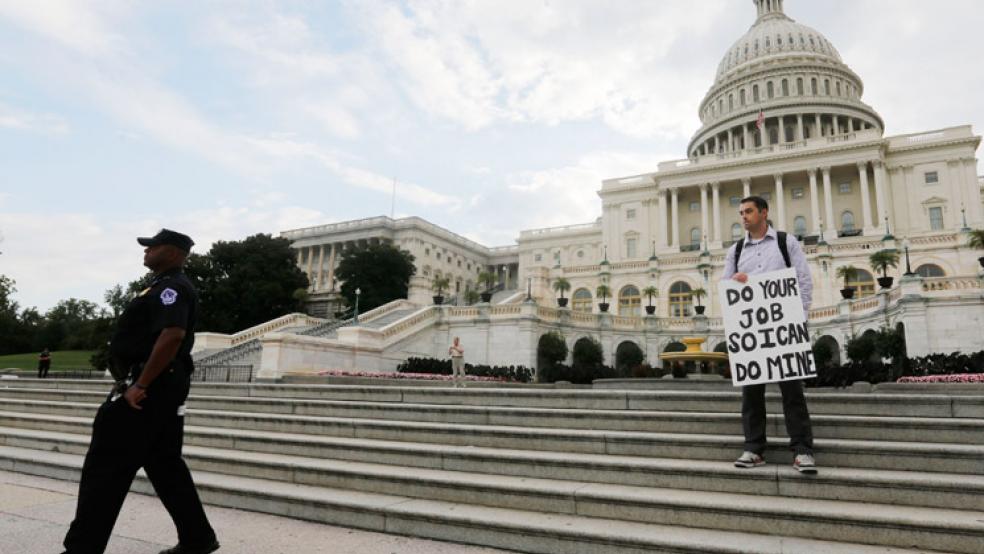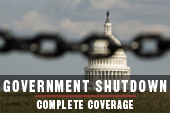You’ve likely heard the number about 800,000 times already: Approximately that many federal workers have been furloughed because of the partial government shutdown that began last Tuesday. That number will be cut nearly in half now that Defense Secretary Chuck Hagel has called back almost all of the roughly 350,000 furloughed civilian employees of the Defense Department.
Still, if the number of furloughs sounds big, just how big is it? And what does having that many workers sent home without pay – temporarily, since Congress appears set to follow historical precedent and grant them back pay after the shutdown is resolved – really mean for the economy?
“The federal government is America’s largest employer,” President Obama noted before the shutdown started – a point that critics charge is part of the problem.
“In the event of a government shutdown, hundreds of thousands of these dedicated public servants who stay on the job will do so without pay – and several hundred thousand more will be immediately and indefinitely furloughed without pay,” the president said. “What, of course, will not be furloughed are the bills that they have to pay - their mortgages, their tuition payments, their car notes.”
The 800,000 workers initially affected represent over a third of the more than 2.1 million civilian federal workforce, not including nearly 600,000 at the U.S. Postal Service who aren’t affected by the shutdown.
RELATED: FEDERAL WORKERS FEELING STING OF THE SHUTDOWN
As the Associated Press pointed out, the original numbers of furloughed workers was “equivalent to the combined workforce of Target, General Motors, Exxon and Google.” The Pentagon’s recalling hundreds of thousands of workers is like taking Target and its 361,000 employees off that list.
Purely in terms of numbers, the employees initially affected are roughly equal to the populations of major urban centers such as San Francisco (826,000), Columbus, Ohio (810,000) or Charlotte, N.C. (775,000) and larger than the populations of cities such as Detroit (701,000), Memphis (655,000), Boston (636,000), Seattle (635,000), Denver (634,000) or, yes, Washington, D.C. (632,000). The return of nearly 400,000 Defense workers would leave the furloughed population more on par with cities such as Omaha (422,000), Miami (414,000), Oakland (401,000) Minneapolis (393,000) or Cleveland (391,000).
Those numerical comparisons don’t carry through to the economic impact of the furloughs, which economists expect to be fairly modest – about 0.2 percentage points of gross domestic product a week, or about $300 million a day out of the $15.7 trillion annual U.S. economy, according to IHS Global Insight economist Doug Handler.
“You can knock government all you want, but we do assume that they provide a useful role to the economy,” Handler says, adding that the economic impact could grow as the shutdown drags on. “If this continues for an extended period of time then the people dependent upon government services, either as in input or as a customer, are going to have more difficulties doing business, will see inefficiencies and may even start laying off other people, and that will increase the 0.2 percent per week impact.”
The Pentagon’s callback prevents some ripple effects of a shutdown from further damaging the economy. In the wake of that announcement, military contractor Sikorsky Aircraft, the division of United Technologies that makes Black Hawk helicopters, said it would cancel its plans to temporarily lay off nearly 2,000 of its own workers beginning Monday. Other defense contractors may still be planning layoffs.
Yet the shutdown could still have other spillover effects, Merrill Lynch economists warned late last week: “Many sectors that rely on the Federal government for approvals or information are impacted. The tourism and travel industry is hurt by the shutdown of national parks. And companies in the defense industry are already starting layoffs.”
And with House Republicans, Senate Democrats and the White House still at an impasse, the economists lowered their baseline forecast for GDP growth in the current quarter from 2.5 percent to 2 percent on the assumption that the shutdown would last another week.
The economists noted that they’d want to see a long-term deal that eliminated further governing by fiscal crisis before they reverted to a more optimistic outlook. “As we have noted before, the risk to the economy comes not just from the shutdown, but from repeated rounds of brinkmanship that undercut consumer, business and investor confidence,” Ethan Harris and Michael Hanson wrote in a note to clients. “Indeed, if this goes on long enough, we plan to cut growth our growth forecast for next year as well.”






